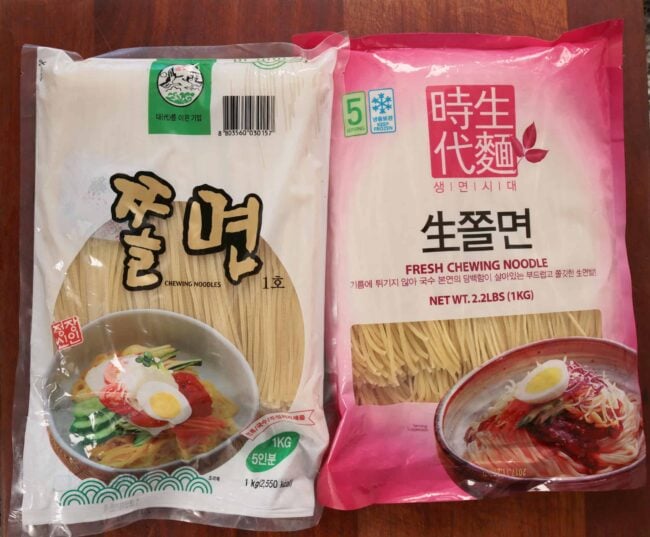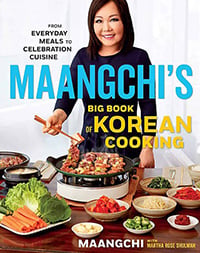Korean jjolmyeon are chewy wheat noodles served chilled in a spicy, sweet and sour sauce with vegetables.
The word “jjolymyeon” literally translates to “chewy noodles” and refers to both the kind of noodles and this recipe. When you cook jjolymyeon they should be elastic and soft, but not tough or hard. Every brand of noodles is a bit different so I suggest you first cook the noodles for five minutes and take a sample to taste. If they’re soft and chewy with nothing hard inside, they’re well cooked. If not, cook them 1 or 2 minutes longer.
You can find jjolmyeon sold in the frozen section of a Korean grocery store. There are 2 types of packages: a jjolmyeon set that includes the noodles and the sauce, and a package that just has the noodles.
2 brands of jjolmyeon noodles, sold without broth
I prefer to buy the just the noodles and then make my own seasoning sauce at home, which is more delicious and cheaper. If you’re in a hurry you can get the set with the sauce, but I suggest that when you make jjolymyoen with the kit you dress it up with more seasonings and vegetables, as well as an egg and some toasted gim. And if you can’t find jjolmyeon noodles near you, you can replace them with any other noodles you have on hand, even spaghetti noodles!
Jjolymyeon is a regular dish in Korean snack bar restaurants called bunsikjip (분식집) that also usually serve inexpensive dishes that students love like gimbap, tteokbokki, and ramyeon. I like jjolmyeon but when it comes to cold noodles my favorite is still bibim-naengmyeon, where the noodles are thinner and darker. I also love kimchi-bibimguksu, where the noodles are not chewy at all and are mixed with kimchi and gochujang (hot pepper paste).
But chewy jjolmyeon, mixed with the spicy sauce, soybean sprouts, vegetables, and toasted gim has such a unique refreshing flavor and texture that it’s unforgettable and has a special place on my menu.
Try it out and make your summer more delightful! : )
Ingredients
Serves 2
- 1 pound of jjolmyeon noodles, thawed out in the fridge (substitute with any noodles you have)
- 12 ounces soybean sprouts
- 2 or 3 cabbage leaves, shredded thinly
- ¼ cups’ worth carrot, cut into matchsticks
- ½ of a seedless cucumber, cut into matchsticks
- 1 sheet of dried seaweed paper (gim), toasted and shredded, kept fresh in a plastic bag
- 1 hard-boiled egg, cut in halves
- 1 green onion, chopped
- kosher salt
For the seasoning sauce:
- ⅓ cup hot pepper paste
- 1 tablespoon soy sauce
- 1 tablespoon Korean hot pepper flakes (gochugaru)
- 2 tablespoons white or apple vinegar
- 2 cloves of garlic, minced
- 2 tablespoons rice syrup (or corn syrup, or sugar)
- 1 tablespoon toasted sesame oil
- 1 tablespoon toasted sesame seeds
Directions
Make the sauce and prepare the soybean sprouts
- Combine seasoning sauce ingredients to a bowl and mix well.

- Pick out any rotten soybean sprouts, then rinse and drain a few times in cold water.
- Put the soybean sprouts in a pot and add 2 cups water with ½ teaspoon kosher salt. Cover and boil for 12 minutes over medium heat.
- Put half of the sprouts in a large mixing bowl so they can cool down. What’s left in the pot will be served as a soup with the jjolmyeon, so keep it hot.
Cook the noodles
- Bring a large pot of water to a boil.
- Add the noodles to the boiling water.

- Stir with a wooden spoon or tongs occasionally so that they don’t stick to each other. Cover and let cook for 5 minutes over medium high heat.
- Take a sample to see if the noodles are cooked properly. They should be chewy but soft. If they’re not soft enough, cook them for another 1 or 2 minutes.
- Strain and rinse the noodles in icy cold water. Rub the noodles with your hands in the cold water to remove any excess starch and to cool them down. Strain.
Mix and serve
- Add shredded cabbage, shredded carrot, and the seasoning sauce to the bowl with soy bean sprouts. Mix it with the wooden spoon.


- Add the noodles, toasted sesame oil, and sesame seeds. Gently mix it up by hand. You can add a few pieces of ice cubes to make them cold. You can wear a plastic glove, if you want. It will be cold!

- Divide into 2 portions and put them into 2 large shallow bowls. Add cucumber, shredded gim, and half an egg on top.
- Add salt and some chopped green onion to the soybean sprout soup to your taste. Serve with the jjolmyeon.

Maangchi's Amazon picks for this recipe
It's always best to buy Korean items at your local Korean grocery store, but I know that's not always possible so I chose these products on Amazon that are good quality. See more about how these items were chosen.











































Warning! If you are using DRY noodles, use less noodles! Try 2/3 of the amount of noodles if you are using dry noodles, so 10.7 oz if you are making a two-person batch with dry noodles.
The noodles Maangchi has in the recipe need to be defrosted, so they are a type of fresh noodle.
We did not think about this. We used angel hair pasta to make 1/2 batch to try it out because we had all the ingredients except the jjolmyeon noodles. It was so very tasty, but we had way too much noodles for the sauce and vegetables.
We have an electric stove with coil burners. We toasted the gim by waving it an inch above the hot burner, not touching.
Maangchi, thank you for another delicious recipe! Maybe make a note about using less dry noodles if someone can’t get jjolmyeon?
Also, you switch between “jjolmyeon” and “jjolymyeon.” Is there a difference?
Made Jjolmyeon at home. It was terrific! Thank you Maangchi !
See full size image
This was super easy to make and delicious. It’s usually hard to find a dish that’s cold and spicy! Loved it! Kamsamida, Maangchissi!!
See full size image
Yum!! Thank you, Maangchi ❤️ :D
See full size image
Yum! : )
Hi Maangchi, I am interested to make a noodle recipe but cannot decide between the jjolmyeon and the bibimguksu May I know what are the differences in the flavour profile please?
Thank you! Love your recipes
Bonjour ! Beaucoup plus de légumes et de finesse dans la sauce ici ✌
I just had this for dinner with my partner. I made the red pepper paste myself as I have celiac disease and malt is a huge no-no. I found a recipe for “instant” gochujang made with fermented soybean paste and sugar instead of malt. Although I have no way of telling how close it is to the real thing, the final result with this recipe was extremely good so very I’m glad!
My red pepper flakes were of the spicier kind, though, so we were really getting our asses kicked XD (which we enjoy)
I’ll definitely make it again.
“malt is a huge no-no” lol your expression is so funny!
This turned out great with red lentil noodles! It was my first time cooking lentil noodles, and I was so surprised that they were almost as chewy as 쫄면! I only had julienned red bell pepper and 콩나물 to mix in, but it was still tasty!
One of my favorite Korean recipes ever… Here is my version using à Tunisian traditional couscous plate! Love this
See full size image
I know this is very late, but I’m seeing your photo just now. It looks great!
Thank you so much for taking the time to reply to my photo!
I made jjolmyeon on a hot August day and everyone enjoyed the cold but very spicy noodles.
See full size image
So so so delicious. I had to substitute the noodles, as my son needs a gluten-free diet, but
the rice noodles I used (쌀소면) were chewy and perfect, too.
Every single recipes of yours I tested so far was wonderful. Thank you! <3
It is very hot in here at the moment ! So for dinner we had jjolmyeon party :) Delicious !
See full size image
The photo proves you were ready to mix all these in a few seconds! : ) Yes, it should be delicious!
Hello Maangchi!! This recipe looks great, but I was wondering if I can make this ahead of time will it still be good? Will the noodles get soggy in 3-4 hours??
Best,
Tony
I made a really large 24 oz jar of the sauce in June, and keep it in the refrigerator. It won’t go bad, since the gochujang and soy sauce both contain large amounts of salt.
I’d suggest making the sauce ahead of time, and cooking/rinsing the noodles just before serving. The noodles will get too soggy if you cook them and/or mix in the sauce that far in advance! Also, if you have access to perilla leaves (ggaennip), chiffonade some and try adding that.
You can use naengmyeon noodles with this sauce as well. If using naengmyeon noodles, cubed watermelon (along with the mix-ins already suggested by Maangvhi) is a surprising tasty and popular combination in Korea. Hope that helped. :)
What a great answer and a big help! Thank you!
Made them tonight! That sauce is good :)
See full size image
Mouthwatering!
Hi Whirled Green Peas!!
I’m to lazy to figure out the measurements ;-)
Would you mind sending how you made this batch of sauce? I’d REALLY appreciate it!!
-C.W.